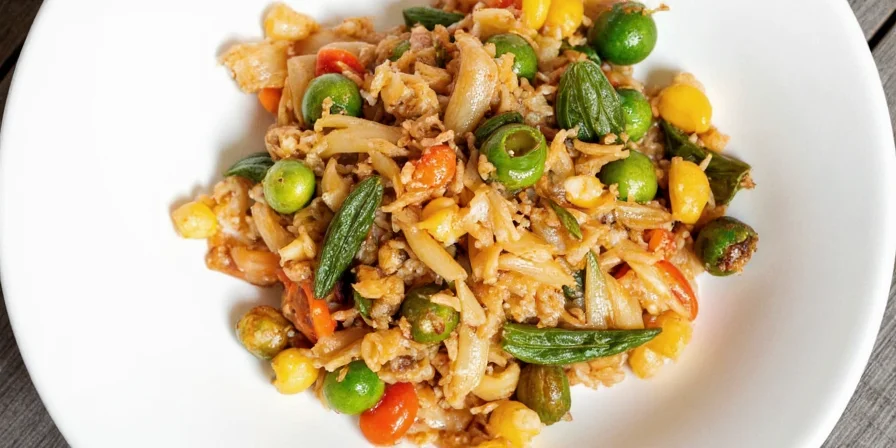Quick Reference Guide
What is the Authentic Mirepoix Ratio?
The standard French mirepoix ratio is 2 parts onion : 1 part carrot : 1 part celery by volume. This precise balance creates optimal flavor development without overpowering any single vegetable. For every 1 cup of diced onions, use ½ cup diced carrots and ½ cup diced celery.

Immediate application: Dice all vegetables to uniform ¼-inch cubes. Start with cold pan and medium-low heat (275°F/135°C). Add vegetables in order: onions first (they take longest to cook), then carrots, then celery.
Why the 2:1:1 Ratio Works: Flavor Science Simplified
The 2:1:1 ratio isn't arbitrary—it's chemistry in action. Onions contain more water and sugars than carrots or celery, requiring double the quantity to establish flavor foundation. Here's what happens when you follow this ratio:
- Onions (2 parts): Release sugars first, creating ideal conditions for Maillard reaction
- Carrots (1 part): Add beta-carotene for color stability without overwhelming sweetness
- Celery (1 part): Contribute phthalides that balance bitterness at optimal level

Deviate from this ratio and you'll notice immediate problems: too much celery creates harsh bitterness, excess carrots cause color bleed in sauces, while insufficient onion fails to build proper fond. For consistent results, always measure by volume (cups), not weight.
3 Most Common Mirepoix Mistakes & Professional Fixes
Why does my mirepoix always burn?
Problem: Exceeding 325°F (163°C) causes rapid caramelization and burning.
Solution: Maintain 275-300°F (135-150°C) using thermometer. Start with cold pan, add oil first, then vegetables. Stir only when moisture releases naturally (every 2-3 minutes).
Can I substitute other vegetables?
Problem: Carrots bleed color in white sauces; celery unavailable.
Solution: For cream sauces, replace carrots with parsnips (use 25% less). For vegetarian dishes, add ¼ cup diced fennel instead of celery for similar aromatic properties without bitterness.
How do I prevent soggy mirepoix?
Problem: Vegetables release too much water, steaming instead of sweating.
Solution: Pat diced vegetables dry before cooking. Use 1 tsp salt per cup of vegetables at start to draw out moisture. Cook in single layer—never overcrowd the pan.
Mirepoix Variations Cheat Sheet: Global Flavor Bases Compared
| Cuisine | Ingredients | Ratio | Critical Technique |
|---|---|---|---|
| French | Onion, Carrot, Celery | 2:1:1 | Sweat without browning; butter preferred |
| Italian Sofrito | Onion, Carrot, Celery, Tomato | 3:1:1:1 | Tomato added early; slow reduction essential |
| Cajun Trinity | Onion, Bell Pepper, Celery | 1:1:1 | Higher heat; pepper prevents sweetness |
| Thai Base | Galangal, Lemongrass, Chili | 1:1:0.5 | Pounded into paste; added after oil heats |
| Spanish Sofrito | Onion, Garlic, Tomato | 3:1:2 | Garlic added late to prevent burning |

Pro Storage & Timing Tips You Won't Find Elsewhere
- Prep ahead: Raw diced vegetables keep 3 days in airtight container with damp paper towel
- Freeze perfectly: Cooked mirepoix freezes beautifully in ice cube trays (up to 6 months)
- Vegan butter substitute: Combine avocado oil with 1 tsp nutritional yeast per cup of vegetables
- Spice timing matters: Add oil-soluble spices (cumin, paprika) to hot fat BEFORE vegetables
- Acid addition rule: Never add wine/vinegar until vegetables are fully softened
- Scrap utilization: Freeze trimmings for stock—carrot peels add color, celery leaves boost aroma

When to Use Different Mirepoix Variations
Choose your base based on final dish requirements:
- Cream sauces & white stocks: Traditional 2:1:1 (carrots provide subtle sweetness without color)
- Tomato-based dishes: Italian sofrito (tomato integrates better with acid components)
- Gumbo & jambalaya: Cajun trinity (bell peppers prevent excessive sweetness)
- Asian-inspired dishes: Skip traditional mirepoix; use ginger-garlic base with high-heat oil
Immediate Application: 4 Signature Dishes Using Perfect Mirepoix
- Classic French Stock: Roast mirepoix at 400°F (200°C) for 30 minutes before simmering
- Coq au Vin: Sweat mirepoix before searing chicken to build fond layers
- Vegetable Risotto: Bloom minced shallots in butter first, then add rice
- Clear Consommé: Blanch vegetables first to prevent cloudiness












 浙公网安备
33010002000092号
浙公网安备
33010002000092号 浙B2-20120091-4
浙B2-20120091-4